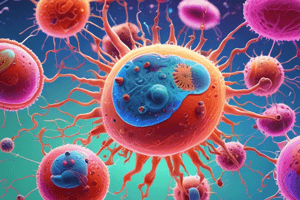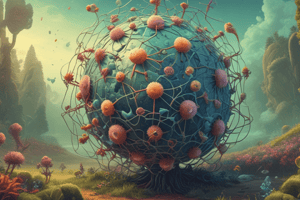Podcast
Questions and Answers
What is the main difference between viruses and bacteria regarding their energy production?
What is the main difference between viruses and bacteria regarding their energy production?
- Bacteria are dependent on host cells for replication.
- Viruses produce energy through binary fission.
- Viruses do not possess metabolic enzymes for energy production. (correct)
- Bacteria lack metabolic processes.
Which type of virus is classified as an obligatory intracellular parasite?
Which type of virus is classified as an obligatory intracellular parasite?
- Bacteria
- Insect viruses (correct)
- Animal viruses (correct)
- All of the above
Who hypothesized the existence of infectious agents smaller than bacteria in the early 19th century?
Who hypothesized the existence of infectious agents smaller than bacteria in the early 19th century?
- Robert Koch
- Louis Pasteur
- Jacob Henle (correct)
- Alexander Fleming
What characteristic differentiates viruses from bacteria in terms of nucleic acid type?
What characteristic differentiates viruses from bacteria in terms of nucleic acid type?
How does the size of viruses generally compare to bacteria?
How does the size of viruses generally compare to bacteria?
What does the term 'bacteriophages' refer to?
What does the term 'bacteriophages' refer to?
What does 'sensitivity to antibiotics' indicate in bacteria?
What does 'sensitivity to antibiotics' indicate in bacteria?
Which statement is true regarding the replication of viruses?
Which statement is true regarding the replication of viruses?
Which of the following viruses is classified as an animal virus?
Which of the following viruses is classified as an animal virus?
Which of the following is NOT a characteristic of viruses?
Which of the following is NOT a characteristic of viruses?
Flashcards
Virology Definition
Virology Definition
The study of viruses, including human, animal, bird, bacterial, insect, and mycoplasma viruses.
Virus size range
Virus size range
Viruses range in size from 20 to 300 nanometers.
Virus Replication
Virus Replication
Viruses require a host cell to replicate and reproduce.
virus metabolic needs
virus metabolic needs
Signup and view all the flashcards
Virus vs Bacteria: Cell Wall
Virus vs Bacteria: Cell Wall
Signup and view all the flashcards
Virus vs Bacteria: Organelles
Virus vs Bacteria: Organelles
Signup and view all the flashcards
Virus vs Bacteria: Nucleic Acid
Virus vs Bacteria: Nucleic Acid
Signup and view all the flashcards
Virus vs Bacteria: Infectious agent.
Virus vs Bacteria: Infectious agent.
Signup and view all the flashcards
Virus vs Bacteria: Sensitivity to antibiotics
Virus vs Bacteria: Sensitivity to antibiotics
Signup and view all the flashcards
Hypothesis of the 19th century
Hypothesis of the 19th century
Signup and view all the flashcards
Study Notes
Virology: Introduction and History
- Virology is the study of viruses.
- Viruses are either human, animal, bird, bacterial, insect, or mycoplasma.
- Human viruses include Small pox, HIV(AIDS), Hepatitis A, B, C, D, E, G, Poliomyelitis, and Rabies.
- Animal viruses include RVF, FMD, RP, BVD.
- Bird viruses include NDV, Gumboro, IBV, ILT.
- Bacterial viruses are bacteriophages.
- Insect viruses are baculovirus.
- Mycoplasma are mycoplasmalphages.
Definition of a Virus
- Viruses are very small obligatory intracellular parasites.
- They lack metabolic enzymes and depend on host cells for replication.
- Viruses are 20-300nm in size (nm = 10⁻⁷ cm).
- They are devoid of machinery for energy production and macromolecule biosynthesis.
Differences between Virus and Bacteria
| Feature | Bacteria | Virus |
|---|---|---|
| Cell wall | + | - |
| Organelles | + | - |
| Nuclear membrane | + | - |
| Metabolism | + | - |
| Nucleic acid | DNA and RNA | DNA or RNA |
| Infectious NA | - | + |
| Size | Over 300 nm | Under 300 nm |
| Sensitivity to interferon | - | + |
| Sensitivity to antibiotics | + | - |
| Replication | Binary fission | Host cell dependent |
Origins of Virology
- Ancient civilizations were aware of virus effects and conducted research into causes and prevention.
- The oldest documented record of a virus infection dates back to approximately 3700 BCE, depicting a temple priest with paralytic poliomyelitis symptoms discovered in Memphis, Egypt.
- Evidence suggests Pharaoh Ramses V (1196 BCE) likely had smallpox.
- Smallpox was endemic in China by 1000 BCE, leading to the development of variolation practices involving inhalation or inoculation of pus from lesions into scratches.
History of Virology (19th Century)
- In the late 19th century, a diverse microbial world of bacteria, fungi, and protozoa was recognized.
- Jacob Henle hypothesized the existence of infectious agents too small to be seen under a light microscope, capable of causing diseases.
- This concept wasn't widely accepted at the time due to lack of evidence
History of Virology (1886-1903)
- Adolf Mayer identified a disease (tobacco mosaic disease) affecting tobacco plants and linked it to a causative agent.
- Through experiments, he demonstrated that extracts from diseased plants could transmit the disease to healthy ones.
History of Virology (Late 1800s)
- Louis Pasteur developed methods for producing attenuated rabies virus preparations.
- This method involved progressively drying spinal cords of infected rabbits and inoculating them into animals to provide protection against a virulent form of the virus.
- The resulting vaccine was the first artificially produced one and further research lead Koch who came up with postulates to identify the agent responsible for the infection.
History of Virology (Postulates)
- A specific agent is responsible for a disease.
- That agent must be isolated from a host.
- It can reproduce in a controlled environment.
- When reintroduced to a host organism, it creates the same disease.
History of Virology (Early 20th Century)
- Dmitri Iwanowski discovered in 1892 that extracts from diseased plants could transmit a disease even after being filtered to remove known bacteria.
- Martinus Beijerinick confirmed Iwanowski's findings, and is credited with developing the modern concept of a virus.
- Friedrich Loeffler and Paul Frosch linked a similar agent to foot-and-mouth disease. This demonstrated that these agents affected both plants and animals.
- Landsteiner and Popper showed poliomyelitis was caused by a filterable agent, making it the first human disease identified as having a viral cause.
History of Virology (Mid 20th Century)
- Frederick Twort and Felix d'Herelle discovered bacteriophages (viruses that infect bacteria).
- These bacteriophages became valuable model systems for exploring various aspects of virology, including viral structure, genetics, and replication.
- Walter Reed demonstrated that yellow fever was caused by a virus spread by mosquitoes.
- Max Theiler successfully propagated yellow fever virus in chicken embryos and developed a live attenuated vaccine (strain 17D) that remains in use today
Cell Culture and Virology
- Methods progressed from whole organ cultures to primary cell cultures and eventually to immortalized cell lines.
- Enders and colleagues in 1949 successfully propagated poliovirus in primary human cells.
- Renato Dulbecco developed the plaque assay, which allowed for more accurate quantification of animal viruses by counting plaques on cultures, determined the number of infectious virus particles.
Serological and Immunological Methods
- In 1941, Hirst observed haemagglutination of red blood cells by influenza viruses which proved to be a useful tool.
- In the 1960s and later, improved methods for detecting viruses were developed: complement fixation, radioimmunoassays, and immunofluorescence.
- Enzyme-linked immunosorbent assay (ELISA) and Western blot assays are quantitative and sensitive.
- Kohler and Milstein isolated the first monoclonal antibodies in 1975, enabling more precise study of virus proteins and wider use in virological assays for wider use in diagnostics.
Electron Microscope Technology and Virology
- Ernst Ruska invented the first electron microscope in 1931.
- The electron microscope overcame the limitations of light microscopes regarding resolution, enabling the direct examination of viruses at magnifications exceeding 100,000x.
- Transmission electron microscopy yields detailed information about virus structure.
- The scanning electron microscope provides three-dimensional images.
Virus Shapes
- Virions are the inert carriers of the viral genome, assembled in cells, but do not grow or divide.
- Viruses vary in shape, including helical, icosahedral, enveloped, and complex forms.
Studying That Suits You
Use AI to generate personalized quizzes and flashcards to suit your learning preferences.
Related Documents
Description
This quiz covers the foundational aspects of virology, including the definition of viruses, their classifications, and differences between viruses and bacteria. You will explore various types of viruses affecting humans, animals, and plants, as well as their structure and characteristics.



